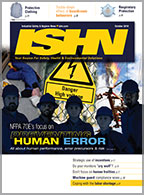Unsafe shortcuts lead to worker deaths, how to liven up safety trainings and the feds limit opioid prescriptions for injured workers. These were among the top occupational safety and health stories featured on ISHN.com this week.
Mississippi manufacturer cited after worker fatality
October 4, 2019
OSHA has cited Howard Industries Inc. – a manufacturer and supplier of electrical transmission and distribution equipment – for exposing employees to struck-by and fall hazards after a fatality at the company’s Laurel, Mississippi, facility. The company faces $53,040 in penalties. The employee was performing a leak test on a transformer when a drive chain supporting the equipment failed.
California fights wildfires with new laws
October 3, 2019
California Governor Gavin Newsom yesterday signed into law nearly 22 measures aimed at preventing and fighting wildfires, which have caused tremendous damage and loss of life in the state in recent years. The bills were based on key recommendations from a state task force.
NIOSH addresses suicide prevention
October 3, 2019
The National Institute for Occupational Safety and Health (NIOSH) has published a new webpage on Suicide and Occupation. The page includes factors that are linked to increased risk of suicide among occupations, ways to prevent suicide in the workplace, and a host of other resources. There were more than 47,000 deaths by suicide in the U.S. in 2017. It was the second leading cause of death among people 10 to 34 years of age.
Good news / bad news about breast cancer in the U.S.
October 3, 2019
Although a decades-long decline in the breast cancer death rate continues (with a slowdown in recent years), breast cancer incidence rates are on the rise. These trends are outlined in Breast Cancer Statistics, 2019-2020, the latest edition of the American Cancer Society’s (ACS) biennial update of breast cancer statistics in the United States, published in CA: A Cancer Journal for Clinicians, and the accompanying Breast Cancer Facts & Figures.
From safety expert Richard Hawk:
Five ways to energize on-site safety trainings
October 3, 2019
As the keynote speaker at the American Architectural Manufacturers Association (AAMA) Fall Conference, safety expert Richard Hawk presented "The Future of Safety in Manufacturing Plants: A Hawk-Eye View of What's on the Safety and Health Horizon." Hawk, who has more than 35 years of experience in the health and safety field, offered tips for how to energize on-site safety trainings at manufacturing plants and facilities.
CDC says this may be behind vaping lung injuries
October 2, 2019
A new report from the CDC sheds some possible light on the spate of lung injuries associated with e-cigarette use. Although the exact cause of the injuries is unknown, the latest findings – which were published in the CDC’s Morbidity and Mortality Weekly Report (MMWR) – suggest that THC products are playing a role in the outbreak.
Two states, two workplace accidents: two workers killed
October 2, 2019
OSHA is investigating two workplace deaths that occurred last Thursday – in Pennsylvania and Illinois. News reports say 38-year-old Luke Marzano was part of a crew cleaning up the site of the former Bethlehem Steel Corp. headquarters – which was demolished four months ago – when he was killed in an incident.
OSHA approves new respirator fit testing protocols
October 2, 2019
OSHA last week issued a final rule approving two additional quantitative fit testing protocols for inclusion in appendix A of the Respiratory Protection Standard. These protocols are: 1. The modified ambient aerosol condensation nuclei counter (CNC) quantitative fit testing protocol for full-facepiece and half-mask elastomeric respirators; and 2. The modified ambient aerosol CNC quantitative fit testing protocol for filtering facepiece respirators.
Not getting enough sleep?
If you have certain health problems, you could be at higher risk for early death
October 2, 2019
Middle-aged adults with high blood pressure, Type 2 diabetes, heart disease or stroke could be at high risk for cancer and early death when sleeping less than six hours per day, according to new research published in the Journal of the American Heart Association, the open access journal of the American Heart Association (AHA).
Is Uber’s driver screening process effective?
October 1, 2019
In the wake of highly publicized incidents involving Uber drivers who physically, verbally or sexually assaulted their passengers, the ride-sharing company is sending out emails touting its background screening process. According to the company, which operates in many cities around the world; “Everyone who drives with Uber is screened before their first trip, and on an ongoing basis.”
ASSP adding virtual participants to classroom safety training
October 1, 2019
The American Society of Safety Professionals (ASSP) is taking its live safety training to the next level by using two-way video projection that will enable virtual attendees to participate from their home or office. The new option – called Live Virtual Classroom – means that safety professionals can enjoy the benefits of face-to-face instruction without the travel time or expense. Virtual participants will be able to ask the instructor questions in real time, interact with the entire class and even join the class when breaking into small groups for discussion.
Risk management failure at root of fatal train crash
Two employees killed, dozens of people injured
October 1, 2019
A collision last year in South Carolina between an Amtrak passenger train and a CSX freight train was caused by CSX Transportation Corporation’s failure to assess and mitigate a specific risk, according to a National Transportation Safety Board (NTSB) investigation. The incident killed two employees and injured 91 passengers and crewmembers.
How manufacturing workers end up with repetitive-motion injuries
October 1, 2019
Working in a manufacturing setting requires many people to perform the same task repeatedly every day. That can mean eight hours or more a day on your feet, as well as straining your back, hips, knees and hands. For those who hope to retire from manufacturing jobs, repetitive-motion injuries — also called repetitive-stress injuries — could prove a bigger risk than a catastrophic workplace accident.
Make a plan during National Fire Prevention Week
October 1, 2019
National Fire Prevention Week (FPW) is just ahead – October 6 – 12 – and the National Fire Protection Association (NFPA) wants you to take small but important actions to keep you and your family safe. The theme for this year’s FPW is, “Not Every Hero Wears a Cape. Plan and Practice Your Escape!” It’s easy to dismiss the possibility of a fire in your home as an unlikely occurrence.
U.S. Steel Corp.'s safety shortcuts lead to fatal explosion
Time and cost concerns blamed in 2 worker deaths and serious burns to another
October 1, 2019
Like most of us, Leo Bridges and Edward Bryant left for work one day in September 2014, probably thinking about some rest and relaxation when the shift ended. Like many, they figured their managers and employer would ensure they were safe at work. Bridges and Bryant were wrong; they were caught in a fiery explosion in the Flux Building, which OSHA inspectors said occurred because U.S. Steel Corp. put workers at risk, so as not to slow production at its Fairfield facility.
New controls limit opioids for federal workers
September 30, 2019
New restrictions on how long injured federal workers can get prescription opioids have been implemented by the DOL's Office of Workers' Compensation Programs, as a way of protecting the workers from the risks of long-term opioid use. The DOL controls – which impose a 7-day limit on the initial fill of an opioid prescription - will apply to injured federal workers receiving benefits under the Federal Employees' Compensation Act.
Exoskeletons may enhance ag safety
September 30, 2019
While considerable exoskeleton research has been focused on manufacturing industry safety, a University of Saskatchewan professor is exploring its potential use in a different area: agriculture. Dr. Catherine Trask, whose specialties include ergonomics, musculoskeletal injury surveillance, exposure assessment and sampling strategies, and evaluation of workplace interventions, is focusing her attention on the prevention of a type of injury that occurs frequently among farmers: back injuries.
OSHA backs away from beryllium rule rollback
September 30, 2019
Contrary to previously announced plans, OSHA will not revoke all of the ancillary provisions in its Beryllium Standards for Construction and Shipyards. Beryllium is a strong, lightweight metal used in the aerospace, telecommunications, information technology, defense, medical, and nuclear industries. Workers who are exposed to beryllium – by inhaling or contacting it in the air or on surfaces - are at risk for developing beryllium disease and lung cancer.
Sharing the sky - safely
September 30, 2019
The Federal Aviation Administration (FAA) is encouraging the drone community to help spread the word on drone safety with the first National Drone Safety Awareness Week taking place, Nov. 4-10, 2019. The FAA’s highest priority is to ensure the safety of the National Airspace System (NAS), and during National Drone Safety Awareness Week, the FAA reminds drone pilots and stakeholders that airspace safety is everyone’s responsibility.


